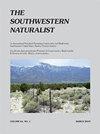WINTERING HABITAT ASSOCIATIONS OF A DECLINING GRASSLAND BIRD, THE SPRAGUE'S PIPIT (ANTHUS SPRAGUEII)
IF 0.2
4区 环境科学与生态学
Q4 Agricultural and Biological Sciences
引用次数: 1
Abstract
Abstract The Sprague's pipit (Anthus spragueii) is a passerine of North American prairies, breeding in the northern United States and southern Canada, and overwintering in the grasslands and deserts of the southern United States and northern Mexico. In recent decades, pipit populations have declined in both breeding and wintering ranges because of degradation and loss of native prairie. Previous research on this species has focused primarily on its breeding habitat and provided limited information on its wintering habitat. To help fill in these data gaps, we assessed wintering density along the Texas Gulf Coast Plain, as well as characteristics of the associated habitat. We used a distance-based line-transect sampling technique to estimate pipit densities during the winters of 2013–2014 and 2014–2015 at seven conservation sites and found Sprague's pipits at all sites. The highest number of detections and the highest density estimates were at the Attwater Prairie Chicken National Wildlife Refuge. Habitat associated with pipits included open grasslands with mixed forbs and low vertical cover. Although wildlife biologists consider pipits to be native grassland specialists in their breeding range, our analyses did not identify proportion of native grasses as an important variable. Instead, the physical structure of the vegetation (short and sparse grass cover) was most important to pipit presence. Our results suggest that habitat management to benefit wintering populations of this species should focus on vegetation structure, though native grassland cover might be important at a larger scale.退化草原鸟类的越冬栖息地关联
摘要Sprague's pipit(Anthus spragueii)是北美大草原的一种雀形目,在美国北部和加拿大南部繁殖,在美国南部和墨西哥北部的草原和沙漠越冬。近几十年来,由于原生草原的退化和丧失,琵琶在繁殖和越冬范围内的数量都有所下降。此前对该物种的研究主要集中在其繁殖栖息地,而对其越冬栖息地的信息有限。为了填补这些数据空白,我们评估了德克萨斯州墨西哥湾沿岸平原的越冬密度以及相关栖息地的特征。我们使用基于距离的样线采样技术来估计2013-2014年和2014-2015年冬季七个保护区的琵琶密度,并在所有保护区发现了斯普拉格琵琶。检测次数最多、密度估计值最高的是阿特沃特草原鸡国家野生动物保护区。与pipits相关的栖息地包括开阔的草原,有混合的杂生物和较低的垂直覆盖率。尽管野生动物生物学家认为琵琶是其繁殖范围内的本土草原专家,但我们的分析并没有将本土草的比例确定为一个重要变量。相反,植被的物理结构(短而稀疏的草地覆盖)对pipit的存在最为重要。我们的研究结果表明,有利于该物种越冬种群的栖息地管理应侧重于植被结构,尽管原生草原覆盖在更大范围内可能很重要。
本文章由计算机程序翻译,如有差异,请以英文原文为准。
求助全文
约1分钟内获得全文
求助全文
来源期刊

Southwestern Naturalist
环境科学-生态学
CiteScore
0.50
自引率
50.00%
发文量
47
审稿时长
18-36 weeks
期刊介绍:
The Southwestern Naturalist (a publication of the Southwestern Association of Naturalists since 1953) is an international journal (published quarterly) that reports original and significant research in any field of natural history. This journal promotes the study of plants and animals (living and fossil) in the multinational region that includes the southwestern United States, Mexico, and Central America. Appropriate submission of manuscripts may come from studies conducted in the countries of focus or in regions outside this area that report significant findings relating to biota occurring in the southwestern United States, Mexico, and Central America. Publication is in English, and manuscripts may be feature articles or notes. Feature articles communicate results of completed scientific investigations, while notes are reserved for short communications (e.g., behavioral observations, range extensions, and other important findings that do not in themselves constitute a comprehensive study). All manuscripts (feature articles and notes) require an abstract in both English and Spanish.
 求助内容:
求助内容: 应助结果提醒方式:
应助结果提醒方式:


